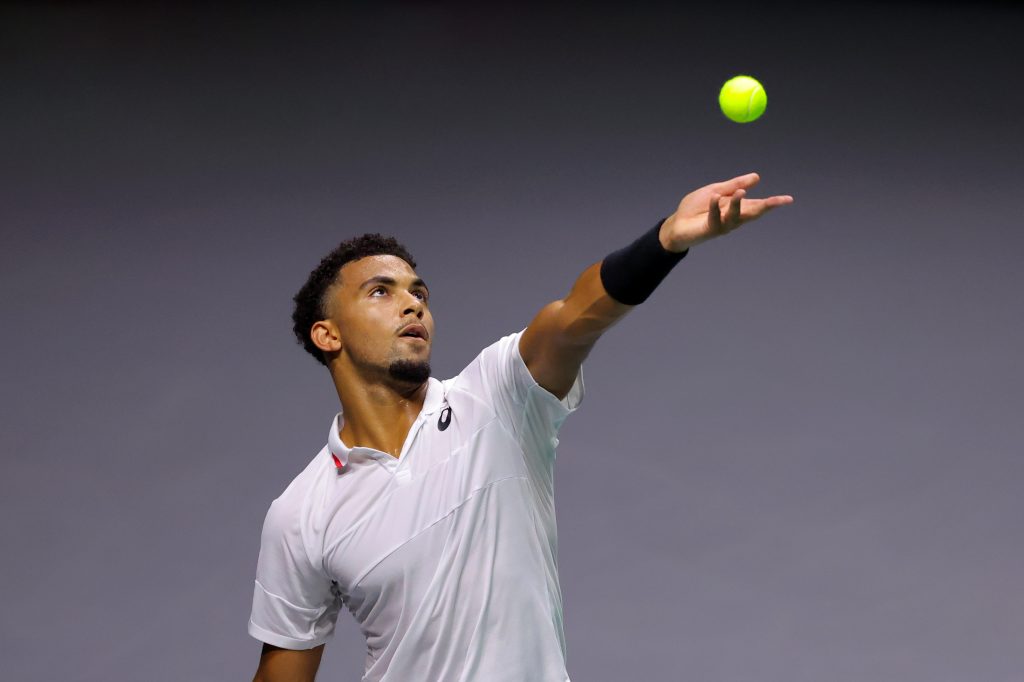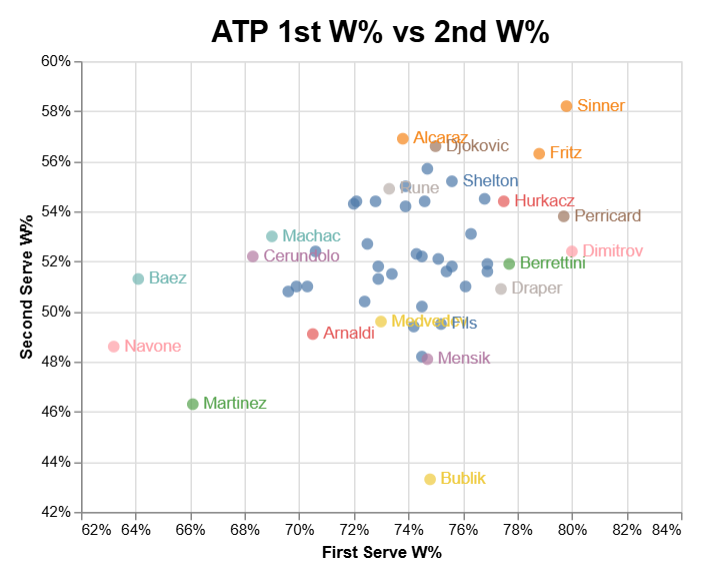
Arthur Fils is a bit of a forgotten prospect. A year younger than Carlos Alcaraz and two years older than Joao Fonseca, he isn’t considered to have the awe-inspiring talent of either. Then again, who does? By any other standard, the 20-year-old Frenchman has made tremendous progress. Standing at #19 on the ATP computer, he’s the top-ranked player under 21, and he’s even within the top five of under-23s.
There’s no secret to the Fils game. He hits hard, smacking serves over 130 miles per hour and occasionally connecting with a forehand that might even cause Fonseca’s eyebrow to twitch. In Saturday’s Davis Cup match against Thiago Seyboth Wild, he scored 11 aces in only 54 service points. He won 29 of 32 points when he landed his first serve.
The Frenchman has plenty more to his game, as well. He is sturdy off both wings, unafraid to battle from the baseline. He rates +5 in Forehand Potency, hardly a tour-leading number, but better than the likes of Daniil Medvedev and Holger Rune. By the same metric, his backhand is neutral. That’s another number that looks better in context: He won’t win any awards, but the shot isn’t holding him back.
At first glance, then, his biggest challenge is making inroads on return. He has won 36.2% of return points over the last 52 weeks, a number just below the usual minimum for an elite player. It ranks him above Rune, Hubert Hurkacz, and Taylor Fritz, but behind most of his fellow top-20 players. It isn’t an obstacle to cracking the top ten, though, as Hurkacz and Fritz have shown.
Fils’s problem now is what happens when he misses that big first serve. Among the ATP top 50, he ranks 16th in first-serve points won, just ahead of Karen Khachanov. By second-serve points won, he ranks a dire 43rd, several places down the list from Sebastian Baez. Even in Saturday’s Davis Cup rout, the Frenchman failed to win half of his second-serve points.
What’s going wrong? Is it something that young players tend to improve? What does a second-serve weak point say about a prospect’s future trajectory?
Second to many
Let’s get a sense of the typical relationship between first- and second-serve win rates. This scatterplot shows the ATP top 50 over the last 52 weeks:

Players who are successful behind one serve are generally successful behind both, with Jannik Sinner leading the way in the upper-right corner. Carlos Alcaraz and Novak Djokovic rank among the second-serve win rate leaders, though their first-serve results aren’t as strong. Grigor Dimitrov and Giovanni Mpetshi Perricard pop out as men with effective first serves who don’t do as much behind the second.
Fils hardly sticks out as a disaster, especially with Alexander Bublik there to distract us. Still, for a man who can win more than three-quarters of his first-serve points, he sits in the wrong part of this grid. There’s virtually no difference between his and Ben Shelton’s first-serve results, yet the American wins five percentage points more often with his second serves. Shelton is top-five in hold percentage, while Fils languishes outside the top 30, despite a near-identical first-serve success rate.
The diagnosis
It’s one thing to say that a player doesn’t win enough points behind his second serve. Can we figure out why?
Start with two things it’s not. Fils commits more double faults than average: 4.1% of serve points versus the typical top-50 rate of 3.4%. But even when he lands his second serve, the results are disappointing. Instead of 43rd among the top 50, he’s 37th. Fewer doubles might be nice, but they would barely move the needle.
We can also cross particularly soft second serves off the list. At the US Open last year, Fils averaged 115 miles per hour on first serves and 92 miles per hour on seconds. That’s a gap of 23 miles per hour–exactly in line with the norm among players who reached the third round. Jannik Sinner averaged 91 miles per hour with his second serves, so raw speed isn’t the problem.
That leaves us with where the second serves are landing. Unscientifically, I get the impression that Fils’s second serves don’t land particularly deep. Khachanov, for instance, hits a bog-standard topspin second, yet it’s fine because he consistently drops it deep in the backhand corner. The Frenchman sometimes hits that serve, but just as often his not-enough-topspin delivery lands in the middle of the box. In 2025, against this field, that’s not going to cut it.
Match Charting Project data can’t tell us how deep the serves are landing, but it does tell us what direction they go:
Dc-Wide Dc-Body Dc-T Ad-T Ad-Body Ad-Wide Fils 2nds 17.5% 38.1% 44.4% 11.3% 20.4% 68.3%
First, the Frenchman rarely goes for the forehand. With a really good second serve, that’s smart. But with less imposing strikes, it gives opponents options. Last week I linked to an analysis of Alcaraz’s loss to Djokovic in Melbourne, where Alcaraz went to the backhand side on second after second–probably too often. That gave Novak the flexibility to position himself differently and play the returns more aggressively. Fils is making a similar offer to everyone he plays, especially on the ad side.
Second, that’s a lot of deuce court serves down the middle. “Body” is misleading–usually when we talk about body serves, we mean the really good ones, flying 125 miles per hour at the returner’s left hip. That’s not what’s happening here. A more appropriate name for the category is something less inspiring, like “serves that aren’t in a corner.” Whether the returner has move a couple steps or none at all, those are booming forehand returns waiting to happen.
Here are the directional breakdowns of a few men with strong second-serve results, for comparison:
Dc-Wide Dc-Body Dc-T Ad-T Ad-Body Ad-Wide Fils 17.5% 38.1% 44.4% 11.3% 20.4% 68.3% Shelton 27.3% 40.3% 32.4% 21.6% 35.0% 43.4% Djokovic 35.5% 38.8% 25.6% 30.6% 27.2% 42.2% Sinner 14.1% 61.5% 24.4% 15.0% 49.8% 35.1%
Both Shelton and Djokovic mix things up a lot more. Sinner does everything I’ve just criticized about Fils and, at least in New York last fall, he did it at the same speed. Sheepish grin emoji. Surely there’s more going on there, but we’ll have to save it for another day.
In development
In one way, clear weaknesses are a good thing. It’s easier to identify a clear target area for practice than to vaguely aim to get a little better at everything. I’m sure Fils and his team are aware that he should get more out of his second serve, and we’ll see him change things up.
The question, then, is if those efforts are likely to bear fruit. Many players struggle to meaningfully improve their stats once they’ve established themselves on tour. It’s hard enough to tread water. Opponents figure out how to counteract their weapons, age and wear-and-tear take their toll, and–if the player is lucky enough to climb the rankings–the average opponent in later rounds is stronger.
Fils has compared himself to Jo-Wilfried Tsonga. Tsonga never had a sub-50% second-serve win rate, but he did have middling figures around 51.5% in his first two years on tour. On the other hand, Tsonga was a late bloomer: He was barely playing Challengers when he was 20.
For a more comprehensive answer, I found 75 men who played full seasons on tour at age 20 since 1991. All but five of them eventually bettered their age-20 second-serve win rate, and the average improvement was 2.7 percentage points. If that holds true for Fils, he’ll peak around 52% on second serves. That’s not bad, though I suspect he would be disappointed if he never does better than that. It would still be an underperformance for someone with his first-strike weapons.
Indeed, the one-third of these players who posted sub-50% second-serve win rates at age 20 improved more than the larger population. They gained 3.4 percentage points. Among them are some names that might inspire even greater feats from the young Frenchman:
Player Age 20 2ndW% Peak Peak 2ndW% Andrey Rublev 49.3% 2020 53.9% Nicolas Almagro 49.1% 2012 55.1% Sam Querrey 48.2% 2015 54.1% Tommy Haas 47.7% 2006 54.8%
All four won fewer second-serve points at age 20 than Fils did in 2024. Each one fully shored up the weakness– at least for one season. 54% isn’t elite, but it’s more than good enough, especially when paired with a top-notch first serve.
To be clear, I’m not forecasting a Haas-like, seven-point improvement for Fils. Repairing weak points at tour level is exceptionally difficult, and even the three-percentage-point norm will take a lot of work. It is nonetheless a challenge the Frenchman will need to undertake. He has come a long way on the back of a big first serve, but to breach the top ten, he’ll need a more well-rounded attack.
* * *
Subscribe to the blog to receive each new post by email:
Great article. Perfectly explained. Thank you, Jeff.
Ótimo artigo. Um trabalho verdadeiramente bem feito e científico!